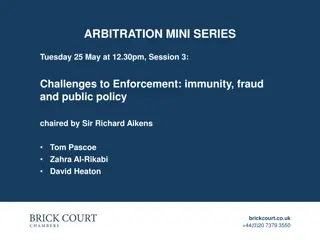The Boundaries of Investment Arbitration: Crossroads of Trade and Human Rights Law
This material delves into the overlapping realms of investment arbitration, trade law, and European human rights law in investor-state disputes. It examines the use of ECtHR and WTO references in arbitration rulings, the nuances of citation choices, the appeal of juridical rulings, and the comparative commonalities between investment treaties and ECHR. The content also explores the expectations versus reality in human rights advocacy within the context of investment arbitration.
Download Presentation

Please find below an Image/Link to download the presentation.
The content on the website is provided AS IS for your information and personal use only. It may not be sold, licensed, or shared on other websites without obtaining consent from the author.If you encounter any issues during the download, it is possible that the publisher has removed the file from their server.
You are allowed to download the files provided on this website for personal or commercial use, subject to the condition that they are used lawfully. All files are the property of their respective owners.
The content on the website is provided AS IS for your information and personal use only. It may not be sold, licensed, or shared on other websites without obtaining consent from the author.
E N D
Presentation Transcript
The Boundaries of Investment Arbitration: The Use of Trade and European Human Rights Law in Investor-State Disputes Jos E. Alvarez
PITAD Data Base (1990-June 1, 2016) 65 Rulings from 343 not discontinued/settled: about 20 percent with ECtHR or WTO reference But 53 with serious ECtHR reference vs. 35 for WTO (but these most likely distinguishing substantive trade) Compare Tables I (ECtHR) and II (WTO) (Case/Treaty/Brief Description/Respective positions of claimants and respondents/panel disposition of issue/topic on which ECtHR/WTO cited)
Caveats Citation Choice of Law May understate b/c mentions in briefs, role in settlements, in rulings not in PITAD, or in other material (e.g., expert opinions) not included; also existing disputes not under contemp. IIAs. May overstate: even 53 with serious references to ECtHR may not affect the final result. Tables only reflect citations in public rulings, not full examination of briefs.
Why do arbitrators cross the road? Appeal of juridical rulings generally for fellow adjudicators Need for gap-fillers Encouraged by some NGOs and academics Appeal of public law Response to ISDS backlash Prominence/legitimacy of ECtHR/WTO rulings Genuine substantive/procedural commonalities between two regimes Variable geometry of VCT rules of interpretation
Progressive Expectations of H. Rts. Advocates vs. Reality Nearly equal references by claimants and respondent states No sign (so far) of harmonization/defragmentation No sign (so far) of resulting humanity s law
Apparent Commonalities b/t IIAs and ECHR Both defend rts to compensation for property deprivations, especially for foreigners Both defend procedural rts to fair process Both defend rts to non-arbitrary and non- discriminatory treatment Both extend rts to humans and other legal persons Both (arguably) protect legitimate expectations Both attempt to balance rts of state and individual
The Use of ECtHR Law: A Selective Survey To interpret IIA provisions: Covering investment Requiring non-discriminatory, non-arbitrary, and fair and equitable treatment Requiring the international min. standard Requiring compensation for direct/indirect takings Requiring full or constant protection Excepting certain measures not precluded
Use of ECHR (conti) To explain the powers of ISDS arbitrators to: Exercise inherent jurisdiction Issue binding interim measures Award and allocate certain forms of damages or costs Retain jurisdiction over a continuous wrong
Use of ECHR (conti) To support general rules : Requiring deference to states Supporting a general rule of proportionality Supporting the application of a margin of appreciation To permit retroactive legislation in non-criminal contexts such as tax To explain what natural justice demands
Competing Lines of Cases Competing visions of whether ISDS is lex specialis: Tulip Real Estate v. Turkey/Rompetrol v. Romania, ST-AD v. Bulgaria, Spyridon Rossalis v. Romania Competing views on ECtHR law s relevance to expropriation: Tecmed v. Mexico, Azurix v. Argentina/Fireman s Fund v. Mexico, Siemens v. Argentina Competing views on the applicability of the ECtHR s margin of appreciation: Continental Casualty v. Argentina, Philip Morris v. Uruguay (Majority)/Siemens v. Argentina, Quasar v. Russia, Bernhard von Pezold v. Zimbabwe
The ECtHRs Margin of Appreciation as Constitutional Principle To respect culturally and geographically delimited European democratic preferences To respect gradualist deepening of ECHR regime To insulate ECtHR judges from charges of judicial activism To manage European-styled form of federalism To manage the ECtHR s caseload To avoid re-opening matters that have been examined under exhaustion of local remedies requirement vs. MofA just a malleable tool of (unpredictable) deference?
Philip Morris v. Uruguay as Case Study: The essential emptiness of many ECHR references The Majority vs. Gary Born s Dissent Disagreement over the lex specialis nature of ISDS vs. the ECHR Regime or just two different views of the interpretation of the Swiss-Uruguay BIT s FET clause?
Problematic Aspects of ECtHR Crossovers Failure to consider/explain whether applicable law One-size-fits-all concept of proportionality Unreflective deployment of margin of appreciation as a form of in dubio mitius Conflation of investment with possessions Ignoring IIA language with respect to distinguishing regulatory takings Ignoring the many different forms of FET Other unreflective boundary crossings (e.g., damages, fair trial, what merits annulment under ICSID)
Trade and Investment Law: Convergence Expectations vs. Reality Convergence expectations: on parallel tracks headed in the same direction / twins wrongly separated at birth E.g., Kurtz s reasons: common telos /common treaties (FTAs) common norms to enhance competitive opportunities prospects for parallel proceedings/forum shopping converging economic logic and realities converging adjudicators produce converging jurisprudence
. . . vs. Complex Realities Only 2 IIAs responsible for 14 of 34 rulings in Table II Many of which refer to procedure and VCT law Considerably fewer evidence of substantive trade-infused investment law Example from direction of ISDS: Methanex v. US (NAFTA) Example from direction of WTO: Essential Security Exceptions and Russia-Ukraine (WTO)(2019)
Comparing WTO Dispute Settlement to ISDS Party Control States vs. Non-state complainants Institutional DSU/App. Body vs. Ad hoc arbitration/Annulment Adjudicators Background Remedies Prospective vs. Retrospective Removal of Measure vs. Damages Perceived Impact on Sovereignty
Comparing human rights tribunals to ISDS Regional h. rtgs. tribunals Full time judges Hearings open to public Claims and decisions available to the public Exhaustion of local remedies required Emphasis on preventing repetition of violation Balanced property right Investor state arbitration Ad hoc arbitrators Hearings normally not open to public Claims/decisions not always available to public Exhaustion of local remedies typically not required Emphasis on remedial damages Property rt not typically subject to explicit balancing
Why Boundary Crossings Matter Relevant to roles/powers of international adjudicators? Relevant to debates about the nature of ISDS? Relevant to ISDS backlash and its remedies (e.g., should we adopt GATT Art. XX/XXI exceptions into IIAs and what to expect if we do?) Relevant to aspirations for defragmentation of public international law?























